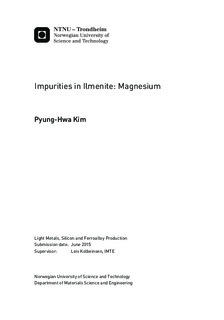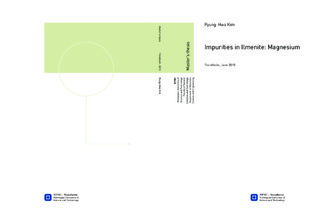| dc.description.abstract | The influence of Mg as main impurity in ilmenite during gaseous reduction with CO and H2 gas was studied in this work. This is of interest for the ilmenite pre-reduction step in the Tyssedal Process as where the impurities in ilmenite tend to give impact to the reduction rate. The work comprises an experimental investigation of synthetic Mg-rich ilmenite pellets with their conversion (reduction) degree, which have been used to isolate the influence of Mg in ilmenite pre-reduction.
Producing synthetic Mg-rich ilmenite, where the target compound is FeTiO3-MgTiO3 (M2O3) solid solution, was the initial task. Synthetic Mg-rich ilmenite ores with different amount of Mg were made by using a CCIF (Cold Crucible Induction furnace) in an inert atmosphere. The slow cooling method used for the synthesis proved the possible production of the FeTiO3-MgTiO3 solid solution without other phases. The XRD analysis showed confirmation of only FeTiO3-MgTiO3 peaks.
Then, the oxidation of synthetic Mg-rich ilmenite was done after pelletizing. Synthetic Mg-rich ilmenite pellets were oxidized in a muffle furnace at the temperature of 1000℃ for 2 hours. The resulted phases after oxidation were ferric pseudobrookite (Fe23+TiO5), rutile (TiO2), magnesium dititanate (MgTi2O5) as expected but also an addition of hematite (Fe2O3). The Mg in ilmenite was thought to hinder the pseudobrookite formation of ilmenite by forming magnesium dititanate ahead in reaction.
The reduction of synthetic Mg-rich ilmenite pellets was done with different ratio of CO and H2 gas for 4 hours. The TGA (Thermo-Gravimetric Analyzer) vertical retort furnace was used, and the mass loss of each sample was recorded and further calculated into conversion degree. Synthetic Mg-rich ilmenite pellet samples with different amount of Mg were reduced with 50% CO + 50% H2 gas, and they showed lower conversion degree with increasing amount of Mg in ilmenite. Synthetic Mg-rich ilmenite pellets with same amount of Mg were reduced with different amount of H2 gas in the gas mixture, and they showed higher conversion degree with increasing amount of H2 gas. The comparison of conversion degrees of each sample showed two clear indications: Mg in ilmenite hinders the reduction rate, whereas H2 gas enhances the reduction rate.
In addition, the conversion degree for the sample reduced with only H2 gas was approximately 1.18 after 4 hours, which indicated addition mass from the supposedly inert rutile (TiO2). Instead of finding phases of reduced rutile however, only phases of Mg, Ti oxide species were detected. It was thought that Mg in ilmenite diffuses ahead and immediately stabilizes the reduced rutile species by forming Mg, Ti oxide species.
From the experiment of synthetic Mg-rich ilmenite pellets, a clear indication for the influence of Mg in ilmenite reduction was given. The data observed from the relatively pure synthetic ilmenite pellets are believed to give accurate results compared to natural ilmenite pellets. | |

